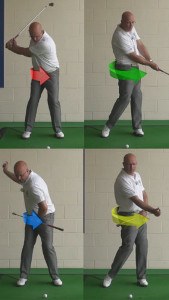
Pivot
In golf, the term “pivot” refers to the rotational movement of the body during the golf swing. It involves the turning of the hips, torso, and shoulders to generate power and accuracy in the shot. Proper pivot is crucial for maintaining balance, generating clubhead speed, and achieving consistent ball striking.
Here are some key points to understand about the pivot in golf:
- Lower body: The pivot starts with the lower body. As you address the ball, your weight should be evenly distributed on both feet. During the backswing, initiate the pivot by turning your hips away from the target, shifting your weight onto your right side (for right-handed golfers). This rotation helps to store energy and create torque.
- Upper body: As the lower body initiates the pivot, the upper body follows. The shoulders and torso should rotate smoothly and on-plane with the swing. The goal is to maintain a coil between the upper and lower body, building potential energy to be released during the downswing.
- Balance: Proper pivot is essential for maintaining balance throughout the swing. As you rotate your body, be mindful of your weight distribution. This allows you to stay stable and in control of your swing.
- Power generation: The pivot is instrumental in generating power in the golf swing. The rotational movement of the hips and torso creates a whipping action, transferring energy from the ground up through the body and into the club. This energy is then released into the ball at impact.
- Consistency: A solid pivot leads to consistent ball striking. When your body is properly aligned and coordinated, it becomes easier to strike the ball with the sweet spot of the clubface. This, in turn, promotes more accurate shots.
Here are some tips to help improve your pivot:
- Maintain a stable lower body throughout the swing. Avoid excessive lateral movement or swaying.
- Focus on hip rotation. Practice turning your hips away from the target during the backswing and towards the target during the downswing.
- Engage your core muscles to support the pivot. Strong core stability will aid in maintaining balance and generating power.
- Practice with drills that emphasize the pivot, such as the “Pivot Drill” where you swing while keeping your back foot (right foot for right-handed golfers) raised off the ground.
- Pay attention to your weight transfer. Shift your weight smoothly from your back foot to your front foot during the downswing.
Remember, the pivot is a fundamental aspect of the golf swing. It contributes to both power and accuracy in your shots. Practice and refine your pivot to improve your overall game and enjoyment of the sport!
- Stop Reverse Pivot With This Practice Golf Drill
- Proper Weight Shift on Takeaway and Downswing – Correct a Reverse Pivot Golf Video – by Pete Styles
- Stop Reverse Pivot with this Practice Drill Video – Lesson by PGA Pro Pete Styles
- The Best Slice Correction Tip in Golf – Reverse Pivot Weight Shift-Video – Lesson by PGA Pro Pete Styles





